Home | Category: Muslim Marriage, Family and Funerals / Arab Life, Marriage, Family and Funerals
MUSLIM FUNERALS
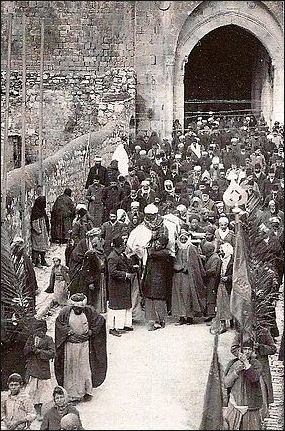
Muslim funeral in Jerusalem After a person dies, mourners recite passages of the Qurʾan. Burial normally occurs on the day of death, after funerary rituals, that include bathing and wrapping the body based on practices of Muhammad. The body is generally taken to a mosque, where the salat al-janazah, a funeral prayer led by a relative or an imam, is said after daily prayers Mourners form a procession, and the body is carried to a cemetery. The shahadah (declaration of faith) is recited by family and friends at the burial. The deceased is placed in the grave with his or her body on the right side and face turned toward Mecca. To reinforce humility and the mindfulness of death, each funeral participant contributes three handfuls of earth toward filling the grave. [Source: John L. Esposito “Worldmark Encyclopedia of Religious Practices”, 2000s, Encyclopedia.com]
Details of Muslim funeral practices are outlined in the Qur’an and a sacred text known as the “Seal of the Prophets” and are based on ancient Bedouin traditions and customs of urbanized Meccans in Muhammad’s time. Burials are required. Cremation is frowned upon. Muslim law forbids the disruption of the remains of the dead. The average cost of a funeral in Egypt was $300 to $2,500 in the mid 2000s.
In accordance with Muslim custom, the dead are buried before sundown or within hours after death. Muslims try to make sure that the body is buried on the day of death, if at all possible, even if close relatives can not attend the funeral, or at the very latest before sundown on the next day if death occurs late in the afternoon. When that happens a candle is lit to ward off evil spirits. The reason for the haste is that dead bodies have traditionally been regarded as unclean and polluting, and disposing of them quickly minimizes inauspiciousness they might bring. Sometimes temporary burials take place. They were traditionally covered in palm leaves.
On his deathbed, A Muslim should declare that he believes in the Oneness of Allah and say "There is no deity save Allah." It is recommended that the dying person lie down facing in the direction of Mecca while a relative reads the surah entitled "Ya' seen." The debts of the deceased should be paid as soon as possible. If dying dies insolvent, debts should be paid from zakah funds of the Muslim community. [Source: Arab News, Jeddah]
Websites and Resources: Islam IslamOnline islamonline.net ; Institute for Social Policy and Understanding ispu.org; Islam.com islam.com ; Islamic City islamicity.com ; BBC article bbc.co.uk/religion/religions/islam ; University of Southern California Compendium of Muslim Texts web.archive.org ; Encyclopædia Britannica article on Islam britannica.com ; Islam at Project Gutenberg gutenberg.org ; Muslims: PBS Frontline documentary pbs.org frontline
See Separate Article ISLAMIC VIEWS ON HEAVEN, HELL, DEATH AND JUDGEMENT factsanddetails.com
RECOMMENDED BOOKS:
“The Muslim Funeral Guide: A Muslim Reflection on Your Death and Afterlife” by Abdullah Bin Hamid Ali Amazon.com ;
“Understanding Traditional Islamic Funerals” by Yasir Uqdah Amazon.com ;
“Muhammad's Grave: Death Rites and the Making of Islamic Society” by Leor Halevi Amazon.com ;
“The Garden and the Fire: Heaven and Hell in Islamic Culture” by Nerina Rustomji Amazon.com ;
“A Concise Description of Jannah & Jahannam: The Garden of Paradise and the Fire of Hell”
by Shaikh 'Abd Al-Qadir Al-Jilani Amazon.com ;
“Judgement Day: Deeds That Light the Way” by Omar Suleiman Amazon.com ;
“The Islamic Understanding of Death and Resurrection” by Jane Idelman Smith and Yvonne Yazbeck Haddad Amazon.com ;
“Al-Ghazali on the Remembrance of Death & the Afterlife” by Abu Hamid Al-Ghazali and T J Winter Amazon.com ;
“Islam Beliefs and Teachings” by Ghulam Sarwar Amazon.com ;
“The Oxford Handbook of Islamic Theology” by Sabine Schmidtke Amazon.com ;
“The Cambridge Companion to Classical Islamic Theology by Tim Winter Amazon.com ;
“Unveiling Islam: An Insider's Look at Muslim Life and Beliefs” by Ergun Caner and Emir Fethi Caner Amazon.com ;
“Islam Explained: A Short Introduction to History, Teachings, and Culture” by Ahmad Rashid Salim Amazon.com ;
“No God but God” by Reza Aslan Amazon.com ;
“Welcome to Islam: A Step-by-Step Guide for New Muslims” by Mustafa Umar Amazon.com
Muslim Funeral Preparations
When a person dies, his or her eyes should be closed, the body should be covered, and the deceased's family should immediately start preparing for the funeral. The body is usually prepared where it dies so that the dead can be purified as quickly as possible for the meeting with God. The body is unembalmed and wrapped in cloth shrouds and not placed in a casket (sometimes it is placed in a coffin but is removed at the graveyard and buried only in a shroud).
The body is washed (preferably with holy water from Mecca). Usually men clean the bodies of men and women clean the bodies of women. Washing usually begins on the right side of the body. Three washings are usually done: the first with plain water, the second with water steeped with acacia leaves and the third with water and camphor. Sometimes salt is added as a purifier. Martyrs are not ritually cleaned because they are believed to be already in a purified state when they die.
The body is wrapped in three layers of clothing (the use of silk is forbidden for men and discouraged for women). The private parts are covered and often the orifices of the body are plugged. Old clothes are often used because it is considered wasteful to use new clothes. Sometimes spices are sprinkled between the body and the clothes. The deceased is then wrapped in clean white muslin shroud that can be up seven meters long. It is important that wrapping to done right so the deceased looks presentable to the angels that escort him to heaven.
Turkey's Ritual Corpse Washers
Istanbul, Turkey's largest city, is home to 16 million people and has 243 ghassals (professional washers of the dead) working in 16 washing cabins that are managed and funded by the municipal government and provide their service for free. Thirty-six-year-old Eda Elal, a ghassal for 16 years, told Reuters: two ghassals normally wash five bodies each day, though the can handle up to 40 a day. [Source: Umit Bektas, Reuters, February 7, 2022]
Reuters reported: “According to the ritual, ghassals pray while washing the body, before placing it in a white shroud ahead of burial. Corpses arrive from hospitals or homes to a washing cabin, called a "ghassilhane", where men wash male bodies and women wash female bodies. “Ceyhan Tunc, 45, another ghassal, who has worked for five years, said "This is a matter of heart." .
“The ghassals are paid by the municipal government but Elal and Tunc said the demanding work is more a responsibility than a source of income. "We try to look at this not from a perspective of money and a job, but rather from a religious duty," Elal said. Elal says her father and husband did not at first support her decision, at age 17, to become a ghassal. But now family is her biggest moral support. "I never had regrets about doing this work because preparing the corpse is the last service to a person. My faith and spirit are satisfied," Elal said, adding that being with someone in "their final moment" made up for the difficulties.
Muslim Funeral Rituals

Shiite funeral for Sheikh Fourati Funerals often take place at night because that is when Muhammad was buried. The deceased are first taken in a procession to a mosque. Often the shrouded body is in a coffin. The funeral bier is set down in the mosque but is carried, presumably so the corpse does not pollute the mosque. An effort is made to keep the head of deceased facing towards Mecca. White is the Islamic color of mourning.
Relatives are permitted to cry at the funeral but they should not shout or wail. Excessive grief is regarded as an affront to God. Even so, sometimes men weep openly and slapped their faces with grief and women sometimes ululate, shriek and pull out their hair to express their grief. Sometimes women aren't allowed to attend funerals, presumably because they are more likely to make outbursts than males.
Inside the mosque, relatives read prayers and the mourners supplicate themselves to ask that Allah forgive the sins of the deceased. A typical funeral prayer, usually led by relative or recognized leader of the Muslim community, goes: “O God, he is thy servant, the son of thy servant and thy handmaid; you led him to Islam, you have taken his spirit. and know him in secret and in the open. We have come to intercede for him and we have made intercessions for him. I take hold of the rope of thy protection for him; he is faithful and under thy care; guard him from the discord of the grave and the punishment of Jahannam.” Martyrs do not require prayers.
A procession from the mosque to the cemetery is held because Muslim regard following such a procession as a good deed. Even though the practice is frowned upon, women sometimes ululate, douses themselves in ashes, cover their faces with dirt or pull out their hair as expressions of grief. During funerals of important leaders or martyrs, the bodies are often lifted and pushed over the heads of the wailing mourners.
Shiite funerals often feature crowds carrying the coffin. After Ayatollah Khomeini died in June 1989 an estimated 10 million people turned out for his funeral. Pandemonium broke out as people tried to touch his corpse and rip off a piece of his shroud. Security forces were unable to hold the crowds back. The torn pieces of his shroud are now regarded as holy relics.
There is no color for mourning in Islam. You may notice that many Muslim brides wear white on their wedding day and same is the color of the cloth for the dead. Also it is not prohibited to wear jewels soon after someone dies in the family, in fact people don't even realize what they are wearing and in what color. they are upset. and if some one wants to recover from the shock and wants to wear jewels , he may do that after getting normal, but not to show off. [Source: Dania Tehreem]
Muslim Burial of the Dead
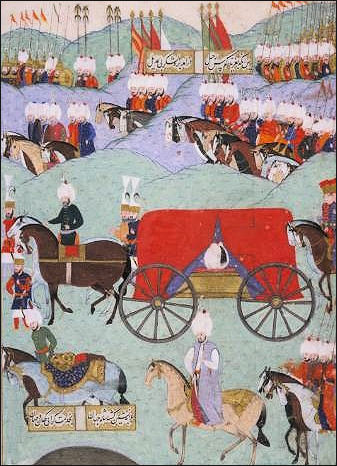
Funeral of Sultan
Suleyman the Magnificent The dead are usually buried in a cemetery in the outskirts of town. The mourners "quietly" carry the body to the graveyard and the deceased is buried in a deep grave "to prevent any bad smell coming out and to stop animals digging." Sometimes graves are left open to accommodate burial within 24 hours after death.
The shrouded body is taken out of the coffin and placed in the grave by three or five male relatives who often crawl into the grave and carefully arrange the body. Women are not allowed to do this. The dead are usually buried on their side facing Mecca. A brick or stone is placed under the head.
Graves are usually angled towards Mecca. Graves and tombs come in a great variety: square ones, niches, brick structures, mausoleums, trenches, graves covered with reeds. Some have scripture of the Qur’an written in Arabic. Women are not supposed to buried next to men.
Originally graves were supposed to be plain and simple and not have tombstones as an expression of humility and equality under Islam. This tradition did not last long. Within a short time after Muhammad’s death, grand mausoleums were raised to honor great men as was the custom in pre-Islamic days. The grandest Muslim mausoleum of all is arguably the Taj Mahal. In Muslim mausoleums the marker in the central room are just representational. The actual tomb is in the crypt below.
After the Funeral and Muslim Mourning
Many Muslims ritually wash themselves after the funeral is over to purify themselves. Sometimes a sheep is slaughtered and a feast is held. Bitter coffee is the traditional Islamic mourning drink. According to Arab tradition, families serve sour coffee to mourners who have come to pay their respects to the dead. Traditional Pakistani condolence calls involve visiting the home of the deceased and sipping tea, chatting and saying the “ fatiha” , the Muslim prayer for the dead.
In some parts of the world relatives read verse from the Qur’an in shifts around the clock until the Muslim sabbath (Friday). In doing this relatives believe they will prevent angels from questioning the deceased before his sins are forgiven on Friday. Sometimes professional reciters are hired to keep the vigil going. [Source: Arab News, Jeddah]
Mourning is forbidden to last for more than 3 days. 40 days period is for the soul to get settled in its new place wherever it is. plucking of hair, shouting and slapping may be instantaneous reactions but they must be controlled quickly. Graves , from the inside , must not be made permanent. one can put a plate on top of the grave, saying who is lying in side. But making a grave with solid bricks is forbidden.
Mourning customs vary and often have their roots in pre-Islamic rituals. The period of mourning can last from a month to a year and is often around 40 days. During that time close relatives wear plain clothes and avoid wearing jewelry or perfumes. Sometimes they refrain from doing their prayers in that time and sometimes they stop working for a week or so. The mourning period for a wife is four months and ten days, unless she is pregnant when it last until the child is delivered. Other female relatives are only allowed to wear mourning clothes for three days. On the anniversary of a person's death his dutiful children are supposed to serve food and drink to the poor.
Muslim remember their dead on Thursday. Many Muslims often return to graves each Thursday during the period of mourning and pour bottles of scented water on the grave and bring back dirt from the graves to their homes. A “ mansaf” is traditional Muslim feast also held to mark the end of a period of morning of a prominent person.
Islam and End of Life Issues
Robin McDowell of Associated Press wrote: “When it comes to end-of-life issues in Indonesia, a country that provides no legal guidelines for doctors, religion plays a role. Islam says all possible steps should be taken to save a dying patient, unless the risks outweigh the benefits, said Dr. Rusdy Malueka, an Islamic ethics specialist. Malueka was among more than 100 hospital directors, doctors and researchers taking part in an end-of-life workshop in the city of Yogyakarta. The meeting, a collaboration between Harvard Medical School and the University of Gadjah Mada, was organized before Suharto fell ill. [Source: Robin McDowell, Associated Press, January 17, 2008]
"There really is no systematic policy at hospitals on how to deal with end-of-life patients," said Retna Siwi Padmawati, a bio-ethics researcher, describing the burden doctors may face in trying to convince families that some cases are futile. Some physicians base their decisions on international guidelines, she said, adding others look for advice wherever they can find it, "from the Internet, for instance." For many families without money or health insurance, end-of-life issues are often determined by cost. When they can no longer afford expensive treatment, they ask doctors to pull the plug.”
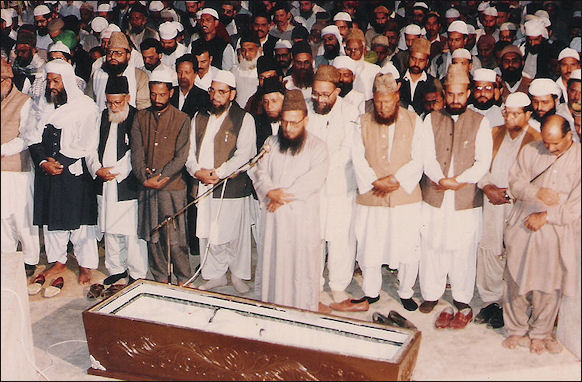
Funeral for Janaza Syed Shujaat Ali Qadri
Chinese Muslim Funerals and Burials
On funeral practices of the Hui in China, C. Le Blanc wrote in the “Worldmark Encyclopedia of Cultures and Daily Life:” “Funeral rites last no more than three days. The body should be washed and wrapped with white cloth (five layers for the woman and three for the man). The Hui practice burial in the ground without a coffin. They dig a perpendicular hollow, more than 12 ft in depth, then make a pit for the body on the west wall of the hollow. The head of the body points toward the north. The body lies on its side, facing west, the direction of Mecca. The Ahung will be invited to recite scriptures during the burying and on the seventh and fortieth day after the death. [Source: C. Le Blanc, “Worldmark Encyclopedia of Cultures and Daily Life,” Cengage Learning, 2009]
The Baoan ethnic group strictly abide by the basic Islamic funeral principles of "burial in the ground", "thrifty and simple burial" and "quick burial". Muslims believes that the a human being is created by the "soil" of the land and thus he should be returned back to the soil when he dies. Burial in the ground after death is to return to one’s birthplace. Chinese Muslim often say "burial in the ground after death is safe" and "burial in soil is like that in gold". They avoid cremation, and do not use inner or outer coffins when burying the dead people in the ground. [Source: Liu Jun, Museum of Nationalities, Central University for Nationalities, kepu.net.cn ~]
The custom of burial in the ground is very simple: 1) select a place at the cemetery, 2) then dig a pit that is about one meter in width, two meters in length and two to three meters in depth in a south to north direction, 3) and then dig a wing-hole on the western pit wall. 4) When the dead person is buried, the head of the corpse is placed in the north direction. The face is placed in the wing-hole so that it faces west towards Mecca. 5) The entrance of the hole is sealed by adobe bricks and mud, 6) then the pit is filled with soil until a grave mound forms on the surface of the ground. Wood boards, stone boards and iron boards and other non-soil items, baked porcelain articles or other grave goods are strictly forbidden in accordance with Muslim burial rules. Most Muslims also frown on the construction of grand, large-scale tombs, although sometimes exceptions are made for revered Muslim saints, and forbid the building of houses on tombs. ~
Islam advocates a thrifty and simple burial, and holds that the funeral should conform to the principle of simplicity, eliminating unnecessary and overly-elaborate formalities. It is particularly critical of anything that hints of ostentation or extravagance. Behind this is the belief that when a human being is born, he is bare and has nothing, so after death, he should also be buried under the same terms. After the death of a person, only an imam is invited to chant scriptures, while family members or funeral specialists wash the corpse with clean water, dress it in a "kafan" (a white cloth and twine used for wrapping the corpse, for women corpses, a cloth to cover the head is added). A corpse needs no any other clothing. Then the corpse is moved into the "tabu" (a rudimentary coffin-like wooden box for carrying corpse in the mosques), and a simple and short funeral is held. Then the corpse is carried to the graveyard and buried in a prepared tomb. During the time of waiting for and holding a funeral, people are forbidden from crying loudly, making an uproar, sending wreaths and funeral couplets, setting off firecrackers, hammering gongs and beating drums, or using any other musical instruments. It is forbidden to create spirit or ancestor tablets as is the custom of Chinese and put up portrait of the deceased. Making sacrifices or presenting offerings is also not allowed. ~
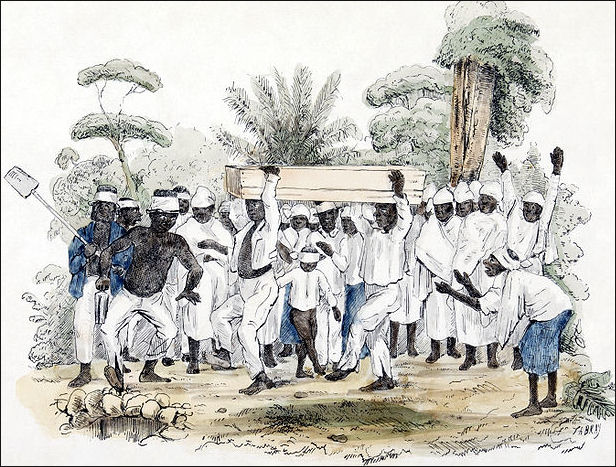
Indonesian Muslim funeral
On the topic of quick burials, the prophet Muhammad said: "you should bury the dead people quickly, if they are happy, they should gain the happiness as early as possible; if they are not lucky, you should let them evade the fire and prison as quickly as possible." Therefore, Islam provides that all Muslims "must be buried within three days after their death" preferably within 24 hours. Islam opposes the custom of waiting for an auspicious lucky day as extravagant and wasteful. Most Muslims try to hold the funeral on the day of the death, not waiting for the next day. Only when the time of death is very late, or some other special situation happens, or close kin of the dead person are far away and cannot return home quickly for the funeral, can the rule be broken to wait for a day. For guiding principal for a quick burial is "the soil in any place can bury people". The dead can be buried anywhere they die. It is not necessary to transport the corpse a long distance to a hometown for a burial. Additionally, it is not necessary to bury the dead together with their ancestors in the hometown as is the custom among Chinese. ~
Simple funeral Muslim practices are observed by the Baoan, Hui, Dongxiang, Salar and other Islamic minorities in China. They believe that a thrifty, simple and quick burial, not only save times and manpower, it also avoids wasting of wealth, and helps prevent the spread of diseases and environmental pollution. ~
Muslim Funeral Customs in Pakistan
On funeral practices in Pakistan, the “Worldmark Encyclopedia of Cultures and Daily Life:” reports: “When a death is about to occur, relatives gather to participate in the death rituals. Passages from the Qur’an are read, the Muslim creed is repeated, and prayers are offered for the dying person. After death, the body is washed, the big toes are tied together, and the corpse is wrapped in a shroud in preparation for burial. The body is carried to the cemetery on a bier by close relatives. At the graveside the mourners, led by a maulvi (religious teacher), pray for the departed soul. The body is placed in the grave on its side with the face towards Mecca. Prayers for the dead, followed by a feast, are held on the third and tenth days after the death. The mourning ritual is completed with a feast for all relatives on the 40th day after the death. [Source: D. O. Lodrick “Worldmark Encyclopedia of Cultures and Daily Life”, Cengage Learning, 2009 *]
D. O. Lodrick wrote:“Baloch burial rites follow usual Islamic practices. The corpse is taken to the graveyard, where it is washed and dressed in a shroud. A mullah reads the prayer for the dead over the body before it is committed to the grave. The body is laid in a north–south direction, with the head turned toward the west, i.e., facing Mecca. Sweets are passed among the congregation, and prayers are offered up before the mourners disperse. For nomads on the move, the body is placed in a pit dug to serve as a grave, rather than in a cemetery. A goat or sheep is killed, and the meat is cooked and distributed instead of sweets. The initial mourning period lasts for three or five days, depending on the sex of the deceased. During this time, normal activities are restricted, and women discard their jewelry and wear black dresses. The end of this period is marked by asrokh, a ceremony involving prayers and the distribution of meat. A second period of mourning lasts several months, during which friends come from a distance to offer condolences to the family of the deceased.” [Source:D. O. Lodrick, “Worldmark Encyclopedia of Cultures and Daily Life”, Cengage Learning, 2009]
“At death, word is sent to relatives and friends, who gather for the funeral. A shroud is sent for from outside the house, and when the mullah (Muslim priest) arrives, the body is carried to a place of washing. It is washed by the mullah and near kinsmen (or the mullah's wife and female relatives, in the case of a woman), then wrapped in the shroud. The body is taken in procession to the graveyard, with the mourners reciting the kalima, the profession of faith. At the graveside, the mullah offers the prayer for the dead, and the body is given its burial. Other rituals include the singing of dirges (moda), and a death feast (varagh). Another feast is held on the first anniversary of the death.
Muhammad Ali's Muslim Funeral
A Muslim funeral was held Muhammad Ali six days after he died at the age of 74 in June 2016 in the boxer's hometown of Louisville, Kentucky. Thousands of admirers and mourners prayed over his body. The jenazah, or funeral in Arabic, was held at a convention space in Freedom Hall, the complex where the former heavyweight world champion defeated Willi Besmanoff in 1961 in his last fight in Louisville. [Source: Steve Bittenbender, Reuters, June 9, 2016]
Steve Bittenbender of Reuters wrote: “An estimated 14,000 people, representing many races and creeds, attended the service, where speakers repeatedly referred to Ali as "the people's champion." "The passing of Muhammad Ali has made us all feel a little more alone in the world," said Sherman Jackson, a Muslim scholar at the University of Southern California.... Imam Zaid Shakir, a founder of Muslim liberal arts school Zaytuna College in Berkeley, California, led worshippers in prayers such as "Allahu akbar" ("God is greatest") over Ali's body, which lay in a casket covered with a black and gold cloth.
Ali and his family planned his funeral for 10 years, making sure it would honor his Muslim faith while also adapting to the demands of Western media-driven culture. Among those at Thursday's funeral was a Bangladeshi man named Mohammad Ali who said he flew to the United States to attend the service despite failing health. He showed pictures of his famous namesake visiting his home nearly 40 years ago. "If I could not attend the funeral of Muhammad Ali, it would be a sad part of my life," he said. "Today or tomorrow, I have to die. So I took the risk and came down all the way because he visited my home."
Ali joined the Nation of Islam and adopted an Islamic name in 1964. In the 1970s, Ali converted to Sunni Islam, the largest denomination among Muslims worldwide. Late in life he embraced Sufism, a mystical school of the faith.
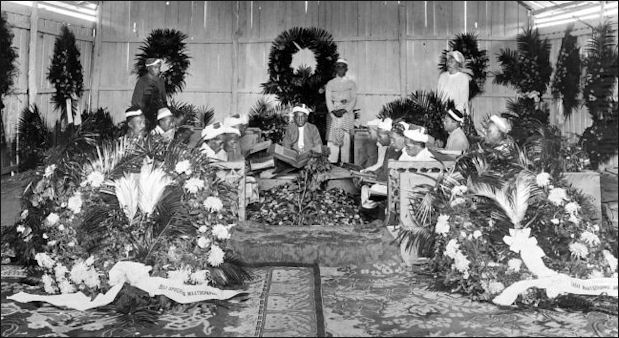
Funeral for Sultan Perkasa Alam Shah
Image Sources: Wikimedia Commons
Text Sources: Internet Islamic History Sourcebook: sourcebooks.fordham.edu ; Arab News, Jeddah; “Islam, a Short History” by Karen Armstrong; “A History of the Arab Peoples” by Albert Hourani (Faber and Faber, 1991); “World Religions” edited by Geoffrey Parrinder (Facts on File Publications, New York); “Encyclopedia of the World’s Religions” edited by R.C. Zaehner (Barnes & Noble Books, 1959); Metropolitan Museum of Art, Encyclopedia.com, National Geographic, BBC, New York Times, Washington Post, Los Angeles Times, Smithsonian magazine, The Guardian, Al Jazeera, The New Yorker, Time, Newsweek, Reuters, Associated Press, AFP, Library of Congress and various books and other publications.
Last updated April 2024
